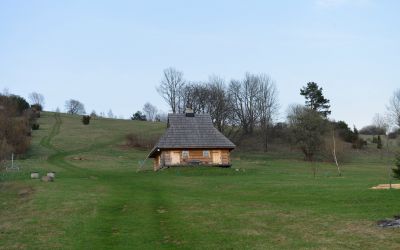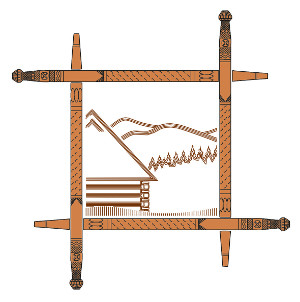Following in the footsteps of Vlach settlers in Bieszczady

Opis produktu
ROUTE NAME: Following in the footsteps of Vlach settlers in Bieszczady
ROUTE TYPE: cycling trail
ROUTE TARGET GROUP: recommended for people travelling alone or for groups of friends
DIFFICULTY LEVEL: route for middle-experienced cyclists
ALTITUDE PROFILE:
Day I - 34 km Day II - 50.5 km Day III - 52 km
ROUTE COURSE:
Lesko – Uherce Mineralne – Orelec – Bóbrka – Polańczyk – Myczków – Bukowiec – Rajskie –Tworylne – Zatwarnica – Dwerniczek – Smolnik – Lutowiska – Czarna Górna – Rabe – Równia – Ustianiowa Górna – Stefkowa – Bezmiechowa - Lesko
ROUTE DESCRIPTION:
Day 1
We start our first day with the Vlach culture trail in Bieszczady in Lesko, heading in the direction of Uherce Mineralne - one of the oldest villages in the Bieszczady Mountains, the first mention of which appeared as early as in 1436. When passing through Uherce, it is good to visit the newly opened Bieszczady Crafts School (PL. Bieszczadzka Szkoła Rzemiosła) where you can participate in workshops devoted to old crafts such as calligraphy, pottery or “proziak” soda bread baking which are organised in an old building of former Austrian school. Then in Orelec we visit the Miodosytnia Studio (PL. Pracownia Miodosytnia) which promotes traditional Carpathian jewellery called "krywulka". Going further, just outside the town of Orelec one can find an atmospheric gallery Galeria Potoki in Bóbrka. On the walls of the gallery you can see magnificent images of icons, shingle or "krywulka" and "gerdany" bead necklaces - all of them are handicraft products made by artists from the Bieszczady region. Numerous art studios and craft ateliers are the hallmark of Bóbrki. A point of sale of traditional sheep and shepherds' cheese "Pod Kapeluszem" is also worth visiting. We continue our journey along road no. 895 through one the most popular tourist towns - Solina, with a beautiful view of Lake Solina, and we reach the Museum of Boyko Culture in Myczków. The museum has numerous exhibit items presenting the cultural heritage of Boykos. In order to eat a tasty dinner, one can visit Oberaża Zakapior (Zakapior Tavern) which specialises in Lemko and Boyko cuisine. Then we move further to the south along the so-called Mała Pętla Bieszczadzka (Small Loop of Bieszczady) and we reach the village of Bukowiec where we end our day. That is a place where you can participate in educational activities devoted to the production of cheeses offered by a certified educational farm "Serowy Raj".
Day 2
On the second day we go to the town of Rajskie and turn right to continue the journey along the San river. After approx. 15 km we can have a short break at the viewing point in Tworylne. The charming San river flowing in that area, rich flora and fauna and the traces of former Boyko villages of Tworylne, Krywe or Hulskie are impressive. Right after passing the viewing point we reach the fork of the road and go to the left which means that we are cycling through the nature reserve "Hulskie im. prof. Stefana Myczkowskiego" which protects the beech and fir-beech forest and the areas of rare and protected species, especially predators such as lynx, wild cat or brown bear. Visitors can also see many species of reptiles and amphibians here, including the fire salamander or Aesculapian snake. We should pay particular attention to the fact that there are over 100 years old beech and fir trees and many other species in the reserve which are recognised as monuments. Then we go to Zatwarnica where we can visit Chatka Bojkowska (Boyko Hut). The reconstructed building in the Boyko style currently functions as the historical and regional centre and the central point of the Ecomuseum "W Krainie Bojków" (“In the Land of Boykos”). Then we reach Smolnik where we visit the St. Michael Archangel's Church - an Orthodox church in Boyko style. Then we follow Wielka Pętla Bieszczadzka (the Great loop of Bieszczady) to the north in the direction of Lutowiska. Several attractive accommodation places can be found here e.g. Trohaniec stud/boarding house where at the foot of Otryt we can enjoy the attractions of a Hucul pony farm - one of the oldest Polish mountain horse breeds. We have also numerous agritourism farms and camping sites at our disposal. We end the day at the viewing point in Lutowiska which offers us a view of the entire High Bieszczady Mountains.
Day 3
On the last day of our trip, we set off on an exploration of the nearest surroundings of Lutowiska. The origins of that village date back to 1580. For centuries, it was inhabited by Lemkos, Boykos, Jews and Poles, just like many other villages in Bieszczady. They lived more or less peaceably and together formed a multicultural community. To commemorate those days, the so-called "museum without walls", namely Ekomuzeum 3 kultury" ("3 cultures ecomuseum"). Then we cycle to the north through Wielka Pętla Bieszczadzka. After reaching the village of Czarna Góra, we stop for a moment to visit a small private Museum of Bieszczady History. The museum includes quite a considerable collection of exhibits, mainly from the nineteenth and twentieth centuries, associated with the entire history of the Bieszczady Mountains, not necessarily only with the Lemko and Boyko history. This small village, however, has interesting secrets. These secrets are hidden under the ground - oil deposits and mineral springs which contributed to the inclusion of the village in the list of settlements that have the proper conditions to conduct spa treatments or exploitation of natural medicinal resources and do not have the status of a health-resort. When exploring the surroundings, we can come across the remnants of the old pre-war oil-producing machines. In Czarna Góra you should also visit st. Dimitrie orthodox church with an interesting iconostasis being included in the Wooden Architecture Trail. Following Wielka Pętla Bieszczadzka and then turning to the west in the direction of Ustaniowa Dolna, we come across as many as six buildings of orthodox churches which are included in the most recognisable tourist trail in the Podkarpackie Province. The following objects are particularly noteworthy: St. Dmitrie the Martyr Orthodox parish church in Czarna and Saint Nicolas Greek Catholic Orthodox church in Rabe which represent the classical style of wooden orthodox church architecture - Greek Catholic Orthodox church of the Intercession of the Theotokos in Równia which is one of few Orthodox churches with three domes remaining in the south-eastern Poland.
After visiting the Saint Paraskewa Orthodox Church in Ustaniowa Górna, we return to Wielka Pętla Bieszczadzka and head for the last wooden architecture object which is located in Stefkowa. Then we go to Olszanica where we turn right before the Post office to reach Bezmiechowa which is situated at the bicycle route of one of the most important trails in Europe - Zielony Rower Greenway Trail in Eastern Carpathians (symbol: R-61). From that point we go to Lesko, which means that during our three-day trip in the footsteps of Vlach culture we went round in a circle.
STAGES, LENGTH OF THE ROUTE AND ESTIMATED TIME:
Day 1
Lesko – Orelec [00:45 h; 11 km]
Orelec – Myczków [00:55 h; 12 km]
Myczków – Bukowiec [00:50 h, 11 km]
Day 2
Bukowiec – Tworylne [01:00 h; 15 km]
Tworylne – Zatwarnica [01:30 h; 17 km]
Zatwarnica – Smolnik [00:55 h; 14.5 km]
Smolnik – Lutowiska [00:15 h; 4 km]
Day 3
Lutowiska – Czarna Górna [00:36 h, 9.5 km]
Czarna Górna – Stefkowa [01:20 h; 25 km]
Stefkowa – Bezmiechowa [00:30 h; 9.5 km]
Bezmiechowa – Lesko [00:30 h; 8 km]
DESCRIPTION OF OBJECTS:
Wooden Architecture Trail - a Polish tourist trail created based on the cooperation of Śląskie, Małopolskie and Podkarpackie provinces. Its main objective is the protection of monuments of wooden architecture as well as the folk culture and art that developed in the villages of the past. Its section leading through the Podkarpackie Province is 1202km long and divided into 9 routes where the most interesting examples of architecture related mainly to Orthodox churches established by the former inhabitants of the region - Lemkos and Boykos can be found.
Boyko Culture Museum in Myczków (PL. Muzeum Kultury Bojków) - a private museum which collects and documents the memorabilia related to the material and spiritual culture of the former inhabitants of the area of the current Solina municipality. The exhibits collected come from Myczków and its surrounding towns e.g.: Polańczyk, Berezka, Wola Matiszowa, Wołkowyje, Terka, Bukowiec, Bereźnica Wyżna and Solina. The museum has also the original folk costumes and clothes of Boykos and of the Polish gentry.
Solina village and Lake Solina - Solina was mentioned for the first time in a document from 1426 as a village situated in the estates of the Kmita family. In the second half of the fifteenth century, the village received another settlement charter under the Vlach law. The construction of dam started in 1960. Some remains of the old village Solina can be found at the bottom of the present reservoir. The dam, 81.8 meters high and 664 m long, is the highest dam in Poland, and Lake Solina is the largest artificial water reservoir in the country.
"3 Cultures" Ecomuseum (PL. Ekomuzeum “3 Kultury”) - a 13-kilometer historical and nature path showing the cultural heritage of three cultures - Jewish, Polish and Ruthenian. Along the route we can visit e.g. Jewish cemetery, synagogue ruins, old Jewish school, remnants of an Orthodox church and Greek Catholic cemetry, old Boyko huts, neo-Gothic church of Saint Stanislaus Bishop and several viewing points with boards informing about the local flora and fauna. We can also find places here where the movie "Colonel Wolodyjowski" was filmed.
St. Michael Archangel's Orthodox Church in Smolnik
The first mention of the existence of the Church in Smolnik dates back to 1589. The church in Smolnik represents a Boyko style which is unique among the remaining Orthodox churches. Nowadays it is the only remaining sacred building of this type in the Bieszczady Mountains and one of three such buildings in Poland. Since 2013, it has been a UNESCO World Heritage Site, along with other wooden Orthodox churches in Poland and Ukraine. Included in the Wooden Architecture Trail of the Podkarpackie Province
EVENTS:
Lesko July - Targi Rzemiosła i Przedsiębiorczości "Agrobieszczady" (EN. „Agrobieszczady” Crafts and Entrepreneurship Fair)
Myczków
May - Noc w Muzeum Bojków (EN. Night at the Museum of Boykos)
Lutowiska
July - Powojenne Targi Końskie (EN. Post-war Horse Fair)
Dwernik
Lipiec - Bieszczadzkie Święto Jagody (EN. Berry Festival in the Bieszczady Mountains)
Ustrzyki Dolne
July - Karpacki Jarmark Turystyczny (EN. Carpathian Tourism Fair)
August - „Święto Chleba” w Muzeum Młynarstwa i Wsi (EN. „The Feast of Bread” in the Milling and Countryside Museum)
September - "Lepszy rydz niż nic"
Zatwarnica
August - Kiermasz Bojkowski (EN. Boyko Fair)
WHERE TO STAY AND EAT:
Oberża Zakapior - Kuchnia Domowa i Bojkowsko-Łemkowska Zdrojowa 37, 38-610 Polańczyk
tel.: 661 075 340
Karczma Solina - Jędrulowa Chata Solina 38a, 38-610 Solina tel.: 603 552 553
Szeptucha Spokojna 28A, 38-610 Polańczyk tel.: 726 194 249
Skalny SPA Zdrojowa 11, 38-610 Polańczyk tel.: 13 469 20 27
Zagroda Bukowiec (Bukowiec Farm)
38-610 Bukowiec, Polska
www.zagrodabukowiec.pl
tel.: +48 506 386 303![]()
U Prezesa
Chmiel 28, 38-713 Lutowiska
tel.: 13 461 08 34
Bieszczadzka Koza Smolnik, Wielka pętla bieszczadzka 25, 38-713
tel.: 509 507 357
Wilcza Jama
Smolnik 23, 38-723 Smolnik
tel.: 530 561 047
Pensjonat Gościniec Rabe (Gościniec Rabe Boarding House)
Rabe 36a, 38-710 Czarna
tel.: 608 438 328
Muzeum Młynarstwa i Wsi w Ustrzykach Dolnych (Milling and Countryside Museum in Ustrzyki Dolne)
Fabryczna 12, 38-700 Ustrzyki Dolne
tel.: 13 461 13 12
Hotel Pałac w Olszanicy (Pałac w Olszanicy Hotel) Mała pętla bieszczadzka, 38-722 Olszanica, Poland
tel.: +48 13 461 74 50
Dodatkowe informacje














